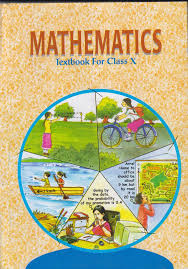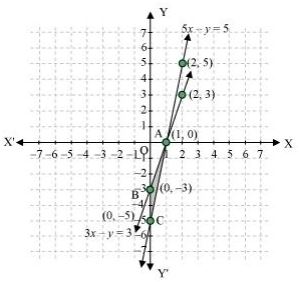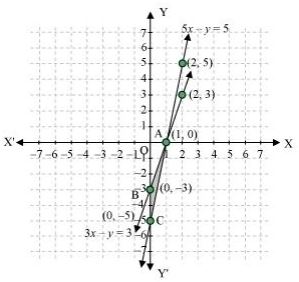Class 10 - Mathematics
Linear Equations In Two Variables - Exercise 3.7

Top Block 1
Exercise 3.7
Question : 1:The ages of two friends Ani and Biju differ by 3 years. Ani’s father Dharam is twice as old as Ani and Biju is twice as old as his sister Cathy.
The ages of Cathy and Dharam differ by 30 years. Find the ages of Ani and Biju.
Answer :
The difference between the ages of Biju and Ani is 3 years. Either Biju is 3 years older than Ani
or Ani is 3 years older than Biju. However, it is obvious that in both cases, Ani’s father’s age
will be 30 years more than that of Cathy’s age.
Let the age of Ani and Biju be x and y years respectively.
Therefore, age of Ani’s father, Dharam = 2 × x = 2x years
And age of Biju’s sister Cathy years
By using the information given in the question,
Case 1: When Ani is older than Biju by 3 years,
x − y = 3 ……….(i)
2x – y/2 = 30
⇒ (4x – y) = 30 * 2
⇒ 4x − y = 60 ………(ii)
Subtracting (i) from (ii), we obtain
3x = 60 − 3 = 57
⇒ x = 57/3
⇒ x = 19
Therefore, age of Ani = 19 years
And age of Biju = 19 − 3 = 16 years
Case 2: When Biju is older than Ani,
y − x = 3 (i)
4x − y = 60 (ii)
Adding (i) and (ii), we obtain
3x = 63
x = 21
Therefore, age of Ani = 21 years
And age of Biju = 21 + 3 = 24 years
Question : 2:One says, “Give me a hundred, friend! I shall then become twice as rich as you”.
The other replies, “If you give me ten, I shall be six times as rich as you”.
Tell me what is the amount of their (respective) capital? [From the Bijaganita of Bhaskara II]
[Hint: x + 100 = 2(y – 100), y + 10 = 6(x – 10)]
Answer :
Let those friends were having Rs x and y with them.
Using the information given in the question, we obtain
x + 100 = 2(y − 100)
⇒ x + 100 = 2y − 200
⇒ x − 2y = −300 ……….(i)
and 6(x – 10) = y + 10
⇒ 6x – 60 = y + 10
⇒ 6x – y = 70 …………(ii)
Multiplying equation (ii) by 2, we obtain
12x − 2y = 140 ………..(iii)
Subtracting equation (i) from equation (iii), we obtain
11x = 140 + 300
⇒ 11x = 440
⇒ x = 40
Using this in equation (i), we obtain
40 − 2y = −300
⇒ 40 + 300 = 2y
⇒ 2y = 340
⇒ y = 170
Therefore, those friends had Rs 40 and Rs 170 with them respectively.
Question : 3:A train covered a certain distance at a uniform speed. If the train would have been 10 km/h faster,
it would have taken 2 hours less than the scheduled time. And, if the train were slower by 10 km/h;
it would have taken 3 hours more than the scheduled time. Find the distance covered by the train.
Answer :
Let the speed of the train be x km/h and the time taken by train to travel the given distance be
t hours and the distance to travel was d km. We know that,
Speed = Distance travelled/Time taken to travel that distance
⇒ x = d/t
⇒ d = xt ……….(i)
Using the information given in the question, we obtain
By using equation (i), we obtain
(x + 10) = d/(t – 2)
⇒ (x + 10)(t – 2) = d
⇒ tx – 2x + 10t – 20 = d
By using equation (i), we get
− 2x + 10t = 20 ………(ii)
(x – 10) = d/(t + 3)
⇒ (x – 10)(t + 3) = d
⇒ tx + 3x – 10t – 30 = d
By using equation (i), we obtain
3x − 10t = 30 (iii)
Adding equations (ii) and (iii), we obtain
x = 50
Using equation (ii), we obtain
(−2) * (50) + 10t = 20
⇒ −100 + 10t = 20
⇒ 10t = 120
⇒ t = 12 hours
From equation (i), we obtain
Distance to travel = d = xt = 50 * 12 = 600 km
Hence, the distance covered by the train is 600 km.
Question : 4:The students of a class are made to stand in rows. If 3 students are extra in a row, there would be 1 row less.
If 3 students are less in a row, there would be 2 rows more. Find the number of students in the class.
Answer :
Let the number of rows be x and number of students in a row be y.
Total students of the class = Number of rows * Number of students in a row
= xy
Using the information given in the question,
Condition 1
Total number of students = (x − 1) (y + 3)
⇒ xy = (x − 1) (y + 3)
⇒ x y = xy − y + 3x – 3
⇒ 3x − y − 3 = 0
⇒ 3x − y = 3 ……….(i)
Condition 2
Total number of students = (x + 2) (y − 3)
⇒ xy = xy + 2y − 3x − 6
⇒ 3x − 2y = −6 ……….(ii)
Subtracting equation (ii) from (i), we get
(3x − y) − (3x − 2y) = 3 − (−6)
⇒ -y + 2y = 3 + 6
⇒ y = 9
By using equation (i), we obtain
3x − 9 = 3
⇒ 3x = 9 + 3
⇒ 3x = 12
⇒ x = 4
Number of rows = x = 4
Number of students in a row = y = 9
Total number of students in the class = xy = 4 * 9 = 36
Question : 5:In a ΔABC, ∠C = 3 ∠B = 2(∠A + ∠B). Find the three angles.
Answer :
Given that,
∠C = 3∠B = 2(∠A + ∠B)
⇒ 3∠B = 2(∠A + ∠B)
⇒ 3∠B = 2∠A + 2∠B
⇒ ∠B = 2∠A
⇒ 2 ∠A −∠B = 0 …………(i)
We know that the sum of the measures of all angles of a triangle is 180°. Therefore,
⇒ ∠A + ∠B + ∠C = 180°
⇒ ∠A + ∠B + 3 ∠B = 180°
⇒ ∠A + 4 ∠B = 180°… (ii)
Multiplying equation (i) by 4, we obtain
8 ∠A − 4 ∠B = 0 … (iii)
Adding equations (ii) and (iii), we obtain
9 ∠A = 180°
⇒ ∠A = 180°/9
⇒ ∠A = 20°
From equation (ii), we obtain
20° + 4 ∠B = 180°
⇒ 4 ∠B = 160°
⇒ ∠B = 40°
∠C = 3 ∠B
= 3 * 40°
= 120°
Hence, ∠A, ∠B, ∠C are 20°, 40°, 120° respectively.
Question : 6:Draw the graphs of the equations 5x – y = 5 and 3x – y = 3. Determine the co-ordinates of the vertices of the triangle formed by these lines and the y axis.
Answer :
5x − y = 5
⇒ y = 5x – 5
The solution table will be as follows.
|
x |
0 |
1 |
2 |
|
y |
-5 |
0 |
5 |
3x − y = 3
⇒ y = 3x − 3
The solution table will be as follows.
|
x |
0 |
1 |
2 |
|
y |
-5 |
0 |
5 |
The graphical representation of these lines will be as above.
It can be observed that the required triangle is ΔABC formed by these lines and y-axis.
The coordinates of vertices are A(1, 0), B(0, -3), C(0, -5).

Mddle block 1
Question : 7:Solve the following pair of linear equations:
(i) px + qy = p – q (ii) ax + by = c
qx – py = p + q bx + ay = 1 + c
(iii) x/a – y/b = 0 (iv) (a – b)x + (a + b) y = a2 – 2ab – b2
ax + by = a2 + b2 (a + b)(x + y) = a2 + b2
(v) 152x – 378y = – 74
-378x + 152y = – 604
Answer :
(i) px + qy = p − q ……… (1)
qx − py = p + q ………. (2)
Multiplying equation (1) by p and equation (2) by q, we obtain
p2 x + pqy = p2 − pq ………… (3)
q2 x − pqy = pq + q2 ………… (4)
Adding equations (3) and (4), we obtain
p2 x + q2 x = p2 + q2
⇒ (p2 + q2) x = p2 + q2
⇒ x = (p2 + q2)/ (p2 + q2)
⇒ x = 1
From equation (1), we obtain
p * 1 + qy = p – q
⇒ p + qy = p – q
⇒ qy = − q
⇒ y = -q/q
⇒ y = -1
(ii) ax + by = c ……….. (1)
bx + ay = 1 + c …….. (2)
Multiplying equation (1) by a and equation (2) by b, we obtain
a2 x + aby = ac ………….. (3)
b2 x + aby = b + bc ……. (4)
Subtracting equation (4) from equation (3),
(a2 − b2) x = ac − bc – b
⇒ x = (ac − bc – b)/ (a2 − b2)
⇒ x = {c(a – b) – b}/ (a2 − b2)
From equation (1), we obtain
ax + by = c
⇒ a{c(a – b) – b}/ (a2 − b2) + by = c
⇒ {ac(a – b) – b}/ (a2 − b2) + by = c
⇒ by = c – {ac(a – b) – ab}/ (a2 − b2)
⇒ by = {c(a2 − b2) – ac(a – b) + ab}/ (a2 − b2)
⇒ by = {a2c − b2 c – a2 c + abc) + ab}/ (a2 − b2)
⇒ by = {abc − b2 c + ab}/ (a2 − b2)
⇒ by = {bc(a – b) + ab}/ (a2 − b2)
⇒ by = [b{c(a – b) + a}]/ (a2 − b2)
⇒ y = {c(a – b) + a}/ (a2 − b2)
(iii) x/a – y/b = 0
⇒ bx – ay = 0 ………..1
ax + by = a2 + b2 ………2
Multiplying equation (1) and (2) by b and a respectively, we obtain
b2 x − aby = 0 ………… (3)
a2 x + aby = a3 + ab2 …….. (4)
Adding equations (3) and (4), we obtain
b2 x + a2 x = a3 + ab2
⇒ x(b2 + a2) = a(a2 + b2)
⇒ x = a(a2 + b2)/ (b2 + a2)
⇒ x = a
By using (1), we obtain
b * a − ay = 0
⇒ ab − ay = 0
⇒ ay = ab
⇒ y = b
(iv) (a − b)x + (a + b)y = a2 − 2ab − b2 ……….. (1)
(a + b) (x + y) = a2 + b2
(a + b)x + (a + b)y = a2 + b2 ……….. (2)
Subtracting equation (2) from (1), we obtain
(a − b)x − (a + b)x = (a2 − 2ab − b2) − (a2 + b2)
⇒ (a − b − a − b) x = − 2ab − 2b2
⇒ -2bx = − 2b (a + b)
⇒ x = a + b
Using equation (1), we obtain
(a − b)(a + b) + (a + b) y = a2 − 2ab − b2
⇒ a2 − b2 + (a + b) y = a2 − 2ab − b2
⇒ (a + b) y = − 2ab
⇒ y = -2ab/(a + b)
(v) 152x − 378y = − 74
76x − 189y = − 37 …….… (1)
− 378x + 152y = − 604
− 189x + 76y = − 302 ………. (2)
Substituting the value of x in equation (2), we obtain
-189{(189y – 37)/76} + 76y = -302
⇒ -(189)2 y + 189 * 37 + (76) 2 y = − 302 * 76
⇒ 189 * 37 + 302 * 76 = (189) 2 y − (76) 2 y
⇒ 6993 + 22952 = (189 – 76)(198 + 76)y
⇒ 29945 = 113 * 265 * y
⇒ 29945y = 29945
⇒ y = 1
From equation (1), w get
76x – 189 * 1 = − 37
⇒ 76x – 189 = − 37
⇒ 76x = 189 – 37
⇒ 76x = 152
⇒ x = 152/76
⇒ x = 2
Question : 8:ABCD is a cyclic quadrilateral (see Fig. 3.7).
Find the angles of the cyclic quadrilateral.

Answer :
We know that the sum of the measures of opposite angles in
a cyclic quadrilateral is 180°.
Therefore, ∠A + ∠C = 180°
4y + 20 − 4x = 180°
⇒ -4x + 4y = 160°
⇒ x − y = − 40° …………(i)
Also, ∠B + ∠D = 180°
3y − 5 − 7x + 5 = 180°
⇒ -7x + 3y = 180° ………(ii)
Multiplying equation (i) by 3, we obtain
3x − 3y = − 120° (iii)
Adding equations (ii) and (iii), we obtain
-7x + 3x = 180° − 120°
⇒ -4x = 60°
⇒ x = −15°
By using equation (i), we obtain
x − y = − 40°
⇒ -15 − y = − 40°
⇒ y = −15° + 40° = 25°
∠A = 4y + 20° = 4(25°) + 20° = 120°
∠B = 3y − 5° = 3(25°) − 5° = 70°
∠C = − 4x = − 4(− 15°) = 60°
∠D = -7x + 20° = -7(-15°) + 20° = 110°

